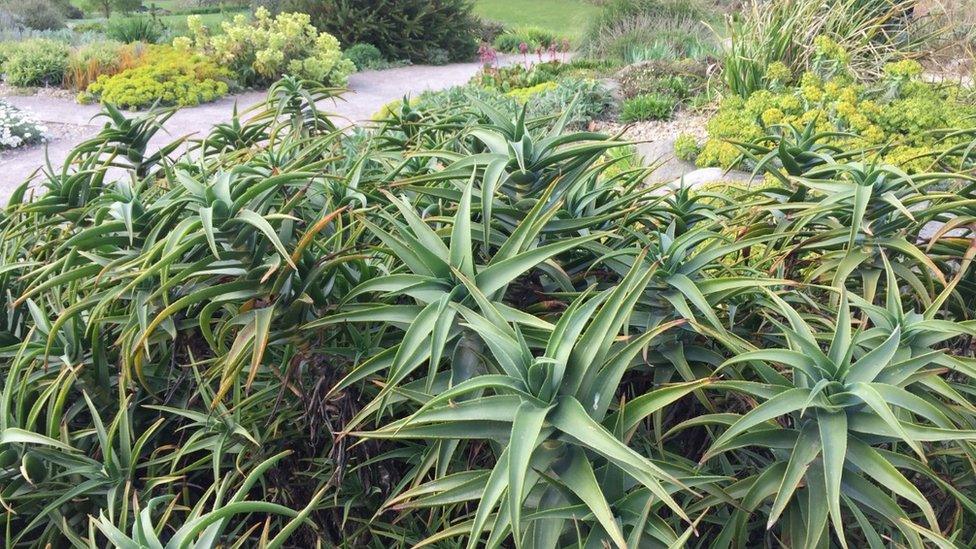Climate change could transform gardens
- Published

The RHS's Harlow Carr garden near Harrogate is already getting a glimpse of conditions to come
Artificial lawns, plants from arid countries and flower beds designed to cope with floods are among future features of UK gardens outlined in a major new report.
As the world warms and weather patterns shift, the study by the Royal Horticultural Society (RHS) concludes that British gardens will need to adapt.
Traditional designs with "immaculate, well-watered lawns" and "Edwardian" borders may be too hard to maintain if the weather becomes more volatile.
The report warns that climate change looks set to bring more extremes and more erratic weather with stronger storms, heavier downpours and more intense heatwaves potentially damaging plants and eroding soil.
But the authors also welcome the prospect of longer growing seasons and say there are new opportunities to use more varied plants in wider areas of the country.
They identify a sharp divide across the UK with climate change bringing contrasting prospects to different regions.
Dr Eleanor Webster, who coordinated the RHS report, told the BBC: "The key thing is that the south of England is going to be hotter and drier throughout the year with some heavy rain showers and then the north of England is going to be certainly milder but it is also going to be wetter in the summer and in the winter.
"The south of England is going to mainly be about water conservation and the north of England is going to be about managing a wet and warm environment."
The report points to the most recent decade being 0.9C warmer than the period 1961-1990 and to an increase in rainfall over Scotland and the north of England over the past century.
But it also says that historical data on the natural world's response to changing conditions is sparse.

Harlow Carr has plants, like these, that are suited to arid conditions
One of the few long-term records has been kept entirely voluntarily by 90-year-old Jean Combes who has noted the precise dates when a handful of trees has come into leaf over the past half-century.
Her note-books show that a particular oak, near her home in Ashtead in Surrey, is now bursting its buds about three weeks earlier than it did in the 1960s.
She describes the first sight of green as "magical" and was honoured with an OBE for her work.
More recent research looks at lawn-mowing as an indicator of climate change and the study says it is now "not unusual" for lawns to have to be cut every month of the year in many UK gardens.
The town of Northampton is seen to mark a rough boundary between two distinct climatic zones.
The RHS study shows how gardeners to the north of Northampton are now mowing their lawns more often in early spring and late autumn, something done south of Northampton for many years.
The report's authors outline three different visions for British gardens by the end of the century.
For the West Country, the scenario suggests an average temperature 3C higher than now with heavy winter rain and more frequent storms.
Many lawns there will become woodland or shrub because mowing would have to be year-round and because it is difficult to mow turf that is water-logged.
Smaller trees will replace larger ones which are more vulnerable to being blown down in strong winds. And slopes will have to be cut with terraces to stop soil erosion.

Jean Combes shows David Shukman the records she has kept voluntarily
The scenario for East Anglia envisages an average temperature 5C warmer than now. Lawns will be replaced by synthetic grass.
Downpipes will channel the limited summer rain to underground tanks. Garden centres will precondition plants to become used to drought. And shade will come from almond, peach and olive trees.
For the north of England, the authors outline a vision of warming of 2C with more winter rain, more extremes and more violent storms. Plants will need to cope with quick swings in conditions.
Raised beds will help with draining heavy rainfall but will also need to be irrigated. The report suggests there will be more robust plants like buddleia and clematis.
In North Yorkshire, the RHS's Harlow Carr garden near Harrogate is already getting a glimpse of conditions to come - and the risks and opportunities.
The overriding concern is handling excessive water. Heavy rain can make the ground so muddy that the garden has to be closed and sudden deluges can lead a small stream to cause flooding.
Curator Paul Cook says the "text books" are a useful guide but more important is to keep watch on the highly changeable weather conditions.
"My biggest worry is that these major weather events do a huge amount of damage to the garden.
"The opportunity is that the improving weather conditions will allow us to grow more plants and a wider range of plants for people to come and enjoy."
By contrast, at the RHS garden at Hyde Hall in Essex - a county that receives relatively little rain - the main preoccupation is finding ways to save water or use it sparingly.
The lack of rain even makes the location suitable for plants including aloe and eucalyptus from arid countries like Chile, Mexico and South Africa.
The garden's curator, Rob Brett, told me: "For Essex, simply because we're in that dry area, the garden demonstrates that you can be growing these sorts of plants."
"You might lose a few now and then in downfalls of rain but generally they're thriving".
Britain's weather will always be highly variable but if the projections in the report prove right, what we think of as a classic British garden will look very different in the decades ahead.
Follow David on Twitter., external